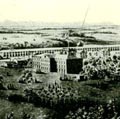|
For Springfield Armory and, especially, the United States, the pay-off
for the many decades of labor and investment in developing mechanized interchangeable
manufacture of military shoulder arms occurred in the Civil War years of
1861-65. Twenty years before the first shots were fired between Federal
and Confederate forces, production of fully interchangeable muskets at
Springfield Armory became, for the first time, a reality. Fifteen years
later, Springfield Armory began production of the revolutionary new US
Model 1855 Rifle Musket – a weapon that set the pattern for those
shoulder arms used by both sides in the Civil War five years later. 
In the first year of the war, Springfield Armory was able to make about
40,000 of these powerful and highly accurate weapons – not nearly
enough for the demands of the Union armies, however. As a result, the nation
turned to supplies of shoulder arms wherever they could be found. For many
regiments, this meant that they fought with serviceable foreign weapons
until enough “Springfields” could be had. They had not long
to wait!
The
second year of the war found Springfield Armory, the sole federal armory
following the destruction of Harper’s Ferry Armory in the first weeks
of the war, kicking its mechanized production system into high gear. Manufacture
of an improved and simplified weapon, the US Model 1861 Rifle Musket, increased
more than four fold that year to about 174,000 only to increase again in
1863, with production of a further simplified rifle musket, the US Model
1863, to about 240,000. The next year, about 250,000 were made with
as up to a thousand made on some days. By the war’s end, Springfield
Armory had provided more rifle muskets that those of all private contractors
combined.
Rifles manufactured by the Springfield
Armory during the Civil War |